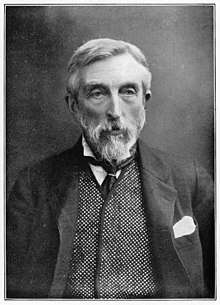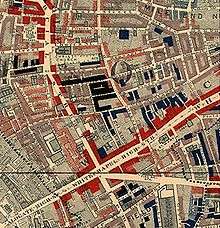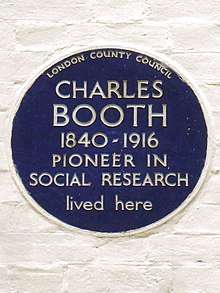Charles Booth (social reformer)

Charles James Booth (30 March 1840 – 23 November 1916) was an English social researcher and reformer known for his innovative work in documenting working class life in London at the end of the 19th century. His work, along with that of Benjamin Seebohm Rowntree, influenced government intervention against poverty in the early 20th century and contributed to the creation of Old Age pensions and free school meals for the poorest children.
Early life and family
Charles Booth was born in Liverpool, Lancashire on 30 March 1840 to Charles Booth and Emily Fletcher. His father was a wealthy shipowner and corn merchant as well as being a prominent Unitarian.[1] He attended the Royal Institution School in Liverpool before being apprenticed in the family business at the age of sixteen.[2]
Booth married Mary Macaulay in 1871, niece of the historian Thomas Babington Macaulay.[2] She was also a cousin of the Fabian socialist and author Beatrice Webb. They had 7 children, 3 sons and 4 daughters.
His eldest daughter Antonia married the Hon Sir Malcolm Macnaghten, and others married into the Ritchie and Gore Browne families.
Career
Booth's father died in 1860, leaving him in control of the family company. He entered the skins and leather business with his elder brother Alfred, and they set up Alfred Booth and Company with offices in Liverpool and New York City using a £20,000 inheritance.[2]
After learning the shipping trades, Booth was able to persuade Alfred and his sister Emily to invest in steamships and established a service to Pará, Maranhão and Ceará in Brazil. Booth himself went on the first voyage to Brazil on 14 February 1866. He was also involved in the building of a harbour at Manaus which overcame seasonal fluctuations in water levels. Booth described this as his "monument" (to shipping) when he visited Manaus for the last time in 1912.[3]
Public health


Booth was critical of the existing statistical data on poverty. By analysing census returns he argued that they were unsatisfactory and later sat on a committee in 1891 which suggested improvements which could be made to them.
Booth publicly criticised the claims of the leader of the Social Democratic Federation H. M. Hyndman – leader of Britain's first socialist party. In the Pall Mall Gazette of 1885, Hyndman stated that 25% of Londoners lived in abject poverty.[4] Booth investigated poverty in London, working with a team of investigators which included his cousin Beatrice Potter (Beatrice Webb) and the chapter on women's work was conducted by the budding economist Clara Collet. This research, which looked at incidences of pauperism in the East End of London, showed that 35% were living in abject poverty – even higher than the original figure. This work was published under the title Life and Labour of the People in 1889. A second volume, entitled Labour and Life of the People, covering the rest of London, appeared in 1891.[5] Booth also popularised the idea of a 'poverty line', a concept originally conceived by the London School Board.[6] Booth set this line at 10 to 20 shillings, which he considered to be the minimum amount necessary for a family of 4 or 5 people to subsist.[7]
After the first two volumes were published Booth expanded his research. This investigation was carried out by Booth himself and his team of researchers. Nonetheless Booth continued to operate his successful shipping business while these investigations were taking place. The fruit of this research was a second expanded edition of his original work, published as Life and Labour of the People in London in nine volumes between 1892 and 1897. A third edition (now expanded to seventeen volumes) appeared 1902-3.[8]
He used this work to argue for the introduction of Old Age Pensions which he described as "limited socialism". Booth argued that such reforms would help prevent socialist revolution from occurring in Britain. Booth was far from tempted by the ideals of socialism, but had sympathy with the working classes and, as part of his investigations, he took lodgings with working-class families and recorded his thoughts and findings in his diaries.
The London School of Economics keeps his work on an online searchable database.[9]
Antisemitism
Booth's 1902 study included antisemitic references to the impact of Jewish immigration, comparing it to the "slow rising of a flood" and that "no Gentile could live in the same house with these poor foreign Jews, and even as neighbours they are unpleasant; and, since people of this race, though sometimes quarrelsome amongst themselves, are extremely gregarious and sociable, each small street or group of houses invaded tends to become entirely Jewish".[10] Although Jews were statistically only a small part of the cigar trade in the United Kingdom, Booth saw the trade as "almost entirely in the hands of the Jewish community" in the East End. [11]
Influence of his work
Life and Labour of the People in London can be seen as one of the founding texts of British sociology, drawing on both quantitative (statistical) methods and qualitative methods (particularly ethnography). Because of this, it was an influence on Chicago School sociology (notably the work of Robert E. Park) and later the discipline of community studies associated with the Institute of Community Studies in East London.
The importance of Booth's work in social statistics was recognised by the Royal Statistical Society, which in 1892 elected him president and awarded him the first Guy Medal in Gold. he was elected a fellow of the Royal Society in 1899.
Politics
Booth had some involvement in politics, although he canvassed unsuccessfully as the Liberal parliamentary candidate in the General Election of 1865. Following the Conservative Party victory in municipal elections in 1866, his interest in active politics waned. This result changed Booth's attitudes, and he foresaw that he could influence people more by educating the electorate, rather than by being a representative in Parliament.[2]
He rejected subsequent offers from Prime Minister William Ewart Gladstone of elevation to the House of Lords as a Peer. Booth engaged in Joseph Chamberlain's Birmingham Education League, a survey which looked into levels of work and education in Liverpool. The survey found that 25,000 children in Liverpool were neither in school or work.
While Booth's attitudes towards poverty might make him seem fairly left-wing, Booth actually became more conservative in his views in later life. Some of his investigators such as Beatrice Webb became Socialists as a result of this research, however Booth was critical of the way in which the Liberal Government appeared to support Trade Unions after they won the 1906 General Election.
Later life

He purchased William Holman Hunt's painting The Light of The World which was donated to St Paul's Cathedral in 1908.[12]
In later life, Booth moved to Grace Dieu Manor near Thringstone, Leicestershire. He died on 23 November 1916 and was buried in the churchyard of Saint Andrew's Church in the village. A memorial dedicated to him stands on the village green. There is also a blue plaque on the house where he lived in South Kensington, at 6 Grenville Place.[13]
Selected works
- Life and Labour of the People, 1st ed., Vol. I. (1889).
- Labour and Life of the People, 1st ed., Vol II. (1891).
- Life and Labour of the People in London, 2nd ed., (1892–97). 9 vols.
- Life and Labour of the People in London, 3rd ed., (1902–03). 17 vols.
Notes and references
- ↑ "Who was Charles Booth? - Charles Booth's London". Booth.lse.ac.uk. Retrieved 5 January 2018.
- 1 2 3 4 Who was Charles Booth? Booth.lse.ac.uk. Retrieved 5 January 2017.
- ↑ Norman-Butler, Belinda (1972). Victorian Aspirations. London: Allen & Unwin. p. 177. ISBN 0-04-923059-X.
- ↑ Fried, Albert & Richard Ellman. (Eds.) (1969) Charles Booth's London. London: Hutchinson. p. xxviii.
- ↑ The reversal of the words in the title of the second volume was due to the original title "Life and Labour" being claimed by Samuel Smiles who wrote a similarly titled book in 1887.
- ↑ Gillie, Alan (1996). "The Origin of the Poverty Line". The Economic History Review. 49 (4): 715–730 [p. 726]. doi:10.1111/j.1468-0289.1996.tb00589.x.
- ↑ Boyle, David. The Tyranny of Numbers. p. 116.
- ↑ Fried, Albert & Richard Ellman. (Eds.) (1969) Charles Booth's London. London: Hutchinson. p. 341.
- ↑ Booth Poverty Map & Modern map (Charles Booth's London) LSE. Retrieved 5 January 2017.
- ↑ Feldman, David. (1994) Englishmen and Jews. p. 166.
- ↑ Alderman, Geoffrey. (1992) Modern British Jewry. Oxford: Clarendon Press. p. 8.
- ↑ "The Light of the World - St Paul's Cathedral". Stpauls.co.uk. Retrieved 5 January 2018.
- ↑ "Charles Booth blue plaque". openplaques.org. Retrieved 11 May 2013.
External links
| Wikimedia Commons has media related to Charles Booth. |
| Wikisource has the text of the 1911 Encyclopædia Britannica article Booth, Charles. |
- Charles Booth's London: Poverty maps and police notebooks LSE
- Works by or about Charles Booth at Internet Archive
- Charles Booth Papers at Senate House Library, University of London
- Spartacus description of Booth's life
- Charles Booth and poverty mapping in late nineteenth century London Middlesex Universities' Business School